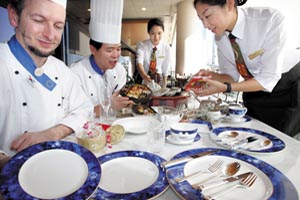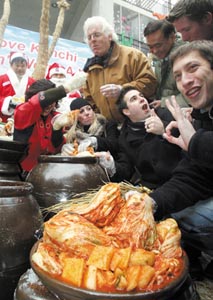 |
Korean dishes lining up to move abroad
Seoul is, by all means, an international city that provides various meals from all around the world. But it's not just about the food you eat: When you go to foreign restaurants, you get to enjoy a different culture as well. When you visit a Turkish restaurant you enjoy Turkish culture; in a Brazilian restaurant, Brazilian culture; and in an Indian restaurant, Indian culture. As you fill your belly and hearts with those foods, part of you is already leaning favorably toward a country you may never have been to in your life. In reverse, think how foreigners would react when introduced to Korean food. So here's our story for today with big dreams for "World Wide Korean Food" |
How do we define orthodoxy in terms of diet in the age of 21st century convergence? Experts classify the concept into two categories -- original and authentic. Original makes an exact replica of past dishes while authentic bases itself on confirmed references to keep up tradition. Frankly speaking, it's anything but easy to revive the exact flavor of the past, not because it's hard to master but because it's hard to pass it down to the next generation. That's because people's taste change bit by bit with the passage of time.
That's where authentic orthodoxy comes in. It makes possible a harmony between old and new, a synergy of East and West, to add something new to the existing frame for further advancement. This is what's required of the present.

Food culture is no exception. If we wish to maintain the vigor of the food while keeping up the basics we need to bear "harmony" in mind. Just like "bibimbap" (boiled rice mixed with vegetables) that combined all kinds of vegetables in one bowl to liven up all the flavors of the ingredients, we need to have an active harmonization within our dishes. It's giving up part of the "old" to bring in the "new" but as a result making the unique quality of the dish better known around the world. It's a change that goes with the rapid pace of international society and also that of Korean society where more and more women enjoy active social life and jobs.
One of the major food trends these days is to bring out the unique tastes of the ingredients. This is due to with the craze for health food. "Even traditional dishes these days are avoiding strong spices with hot or salty tastes," Yoon Sook-ja, director to Institute of Traditional Korean Food said, adding that the latest trend is indeed more about brining out the natural taste of the ingredient rather than cookery.
She added however that it's the deep, pulling taste of Korea, the so-called "taste of the mother's hands" that should be promoted abroad. It should be a taste that no processed food can follow and a taste that comes from a culture of fermented food. That's a bit tricky given that such quality usually takes awhile for foreigners to get used to. Not that it would stop Korea from promoting its dishes however, especially when the world is finally acknowledging the benefits of fermented food.
"To bring Korean food to the world we need to merge with other cultures and produce an appropriate fusion form," Kim Jae-soo, agriculture counselor to the Korean embassy in Washington, D.C. said. "And for starters we could think of ways to ease the strong taste of our "gan-jang" (soy sauce), "doen-jang" (bean taste) and "gochu-jang" (hot pepper paste) which forms the basis of our sauces." Kim said that Korea needs to come up with a new kind of Western style sauce through certain changes in those typically Korean pastes.
Modernization within traditional dining
Other ways to globalize Korean food includes standardizing recipes. A systemic standard must be set for making Korean food, so that anyone -- either at home or abroad -- could follow a proper method for cooking Korean food.
"We are currently experimenting with food to find the right point that could both satisfy Korean and foreign tastes, so that we could standardize the recipe and therefore spread Korean food abroad,?Kang In-kyong manager of the same institute said.
The biggest change made in Korean food so far involves style -- one example: presentation, with the once lumped-together side dishes now being brought out in courses. Bibimbap or janggukbap (steamed rice with beef soup) have morphed into top-rated entr?s with a wide menu of choices similar to Italian spaghetti-based dishes. Also, Korea's wide variety of "juk" (rice porridge) has joined the course line up as an appetizer.
"The course-style Koran dishes are one way to promote Korean food abroad," Joo Hye-joon, a food stylist said. The big hearty dishes laid all at once on a table makes foreigners ill at ease, she explained, since they have no idea where to start. The course menu puts them at ease. "This is one way to get foreigners to appreciate our food twice as much."
Another food stylist, Song Hye-jin, stressed that people no longer eat food just to satiate hunger. "We're living in an era in which people enjoy their meals with their eyes, too. That's how we appreciate our meal to the fullest." She explained, people should also pay attention to the dishes used for serving the food, the interior, the package and the whole setting overall. Song further explained that in that respect it is important to come up with ideas to help the general public become more acquainted with ceramic dishes. Beautiful dishes presented at a reasonable price could be practical as well as help maintain the style of Korean traditional food.
For example the rice-cake caf?"Jilsiru" on Jongno in downtown Seoul has altered its packages and dishes to keep up with modern tastes. "We moved away from the old market and rice-mill image of rice cake to make the caf?into a peaceful and serene place," said one of the workers at Jilsiru. "Our rice cake is not too big or heavy but fits right into the mouth. They come in pretty colors made of various natural ingredients, so they are well received by both locals and foreigners." Satisfying to both eyes and tongue and rich in texture and nutrients, the rice cake has moved from nostalgic treat to trendy snack.
Food that fits the pace of modern society
One of the great merits of Korean food is that it is already health food. The old saying "A good meal is good medicine in itself" was no exaggeration when it comes to Korean food as it can ward off diseases and improve one's condition. "Korean dishes are formed of seasonal eateries matured and fermented with time. It's truly nutritious dishes that have surprised the world," counselor Kim stressed.
Kimchi, doen-jang, gan-jang and gochu-jang are some of the scientifically proven nutritious dishes. Korean food's vegetable-centered meals can also prevent geriatric diseases. Traditional dishes can lower cholesterol and prevent high blood pressure, so they are also good for one's diet. There is no trouble with over eating either since the dishes make one feel full through timely absorption and digestion of the nutrients.
"Our ancestors created various dishes in order to maintain the best condition for the human body. Korean food is a definite winner when it comes to nutrition," Director Yoon said. "It's not about what but how to present these wonderful traditional dishes abroad and help them blend with the others."
"We could also think of ways to make traditional dishes into fast food that could adapt to fast-moving modern society," said Song. True to her words, many food experts agree that some Korean food needs to be re-developed into half-processed food that allows easy cooking.
For example, Gyeok-ja Kalbi Co. specially packaged "seolleongtang" (boiled bone soup with chopped leek) and "galbi" (ribs) for people with a taste for home-cooked meals but no time to prepare them, and the caf?Jilsiru offers take-home packages of rice cakes that can go straight into the microwave. In both cases, the response was great. Take just one step away from the old ways, and we can find great potential lying ahead for our food.
If we simply find the right preparation and presentation formulas, popular dishes like bibimbap could take on the mighty hamburger and pizza. Around the world, people are looking for a fast, nutritious answer to the daily lunch dilemma.



























